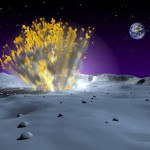Moon twinkles
Flashes of light on the moon’s surface come from cooling, superhot liquid

If you ever travel to the moon, don’t forget to pack a heavy-duty umbrella. It’s not for downpours: With no atmosphere, there’s no chance of rain. But hundreds of times each year, small space rocks smash into the lunar surface, flashing brightly enough to be seen from Earth.
Researchers have long argued about why the collisions lead to light. A new study appears to have solved the mystery. Scientists in Europe say the flashes come from scorching pieces of material kicked up from the lunar surface after the collisions.
Just a small piece of comet or asteroid — about 10 centimeters (4 inches) in diameter, the size of a softball — can trigger a very bright flash, visible from Earth, Sylvain Bouley told Science News. Bouley, a planetary scientist at the Paris Observatory, worked on the new study.
Bouley and his colleagues calculated the brightness of lunar lights that flashed between 1999 and 2007. The team also estimated the size and speed of the objects colliding with the moon. Most softball-sized rocks smash into the surface at about 260,000 kilometers per hour (161,000 miles per hour).
At those speeds, the collisions can produce a lot of energy — as much as 70 kilograms (154 pounds) of TNT. Temperatures can reach thousands of degrees Celsius. The powerful impacts can vaporize part of the crashing rock and the surface, releasing gas and a liquid called melt droplets. It’s these melt droplets that produce light as they cool.
“Something is melting, and because it’s so hot, it [emits light] until it cools down,” Carolyn Ernst told Science News. Ernst, who did not work on the new moon-light study, is a planetary scientist at Johns Hopkins University’s Applied Physics Laboratory in Laurel, Md.
People have been seeing these mysterious moon lights for at least 500 years (always appearing on the shadowed side of the moon), although scientists had never agreed on the flashes’ origins. Scientists used to believe that the lights did not come from the moon itself, but were instead reflections from nearby satellites. Later, they wondered if the lights indicated something brewing within the moon, like churning volcanoes.
The new study now points to origins from above. The findings may help scientists understand more about the moon. They may also help lunar tourists remember to pack a very serious umbrella for space-rock showers.
POWER WORDS (Adapted from the New Oxford American Dictionary)
asteroid The small, often irregularly shaped rocky bodies that orbit the sun. They range in size from specks of dust to several hundred kilometers in diameter. Most orbit in a zone between the orbits of Mars and Jupiter known as the asteroid belt.
lunar Of or relating to the moon.
atmosphere The envelope of gases surrounding Earth or another planet.
radiate Emit energy in the form of waves.







